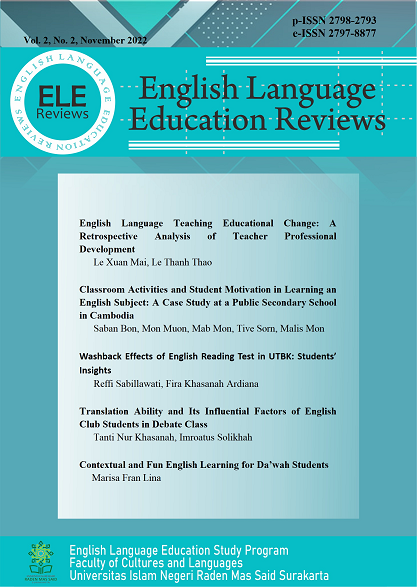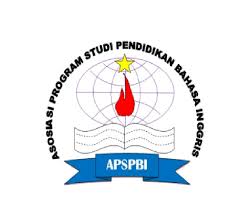Classroom Activities and Student Motivation in Learning an English Subject: A Case Study at a Public Secondary School in Cambodia
DOI:
https://doi.org/10.22515/elereviews.v2i2.5562Keywords:
Cambodian secondary education, student motivation, classroom activitiesAbstract
This study sought to investigate students’ perceptions of classroom activities and their motivation levels in learning an English subject. The study also examined the affiliation between classroom activities and student motivation. The survey questionnaires were employed to collect the data from 120 upper secondary graders studying at a public secondary school in Cambodia. Social Science Version 16.0 (SPSS 16.0) was utilized to analyze. Descriptive statistics and Pear Product Moment Correlation were performed. The results revealed that EFL teachers frequently employed ‘Mechanics’ and ‘Exclusive Use of Language’ in their teaching. The results apropos of student motivation indicated that students had a higher level of motivation in ‘Confidence’, and ‘Motivation about Language’ and the lowest level in ‘Motivation about Class’. The result also revealed that ‘Fun’ positively correlates with ‘Confidence’ and ‘Motivation about Class’. Conversely, ‘Mechanics’ is negatively correlated with ‘Motivation about Class’. Therefore, the study argued that the teachers less frequently employed ‘Fun’ activities that could boost student motivation. In contrast, ‘The teachers commonly practiced mechanics’ activities that could decrease student motivation. In this sense, the study suggested that teachers maximize ‘Fun’ activities and minimize ‘Mechanics’ activities. However, because of the weak and moderate correlation between classroom activities and students’ motivation, the level of student motivation was not mostly determined by classroom activities. Thus, scrutiny of other factors enhancing the level of student motivation could be a topic for future study.
Downloads
References
Aguirre, D., Bustinza, D., & Garvich, M. (2016). Influence of songs in primary school students’ motivation for learning English in Lima, Peru. English Language Teaching, 9(2), 178-191.
Aljuaid, H. (2021). Students’ motivation to learn English as a foreign language in the context of Saudi Arabian learners. Arab World English Journal, 12(3), 242-256. https://doi.org/10.24093/awej/vol12no3.17
Alyousif, R., & Alsuhaibani, Z. (2021). English language learning demotivating factors for Saudi high school EFL students. English Language Teaching, 14(8), 29-39. https://doi.org/10.5539/elt.v14n8p29
Balushi, A., & Rahman, H. M. A. (2020). The reasons of using L1 in ESL classrooms. Language Teaching Research Quarterly, 16, 56-70. https://doi.org/10.32038/ltrq.2020.16.04
Bernard, J. (2010). Motivation in foreign language learning: The relationship between classroom activities, motivation, and outcomes in a university language-learning environment [Dietrich honors thesis] Carnegie Mellon University. https://doi.org/10.1184/R1/6686228.v1
Bon, S. (2022). Developing Cambodian secondary school students’ intercultural competence: Strategies and challenges. Issues in Educational Research, 32(3), 887-905.
Cahyono, B. Y., & Rahayu, T. (2020). EFL students’ motivation in writing, writing proficiency, and gender. TEFLIN Journal, 31(2), 162. https://doi.org/10.15639/teflinjournal.v31i2/162-180
Căprioară, D., & Frunză, V. (2019). Effective strategies to improve student motivation for school learning. European Proceedings of Social and Behavioural Sciences, 1490-1497. https://doi.org/10.15405/epsbs.2019.08.03.183
Clayton, S. (2008). The problem of ‘choice’ and the construction of the demand for English in Cambodia. Language Policy, 7(2), 143-164. https://doi.org/10.1007/s10993-008-9084-9
Daif-Allah, A. S., & Aljumah, F. H. (2020). Differences in motivation to learning English among Saudi University students. English Language Teaching, 13(2), 63-74.
Dörnyei, Z. (2005). The psychology of the language learner: Individual differences in second language acquisition. Routledge. https://doi.org/10.4324/9781410613349
Elliott, J., Hufton, N., Willis, W., & Illushin, L. (2005). Motivation, engagement and educational performance: International perspectives on the contexts for learning. Palgrave Mcmillan London. https://doi.org/10.1057/9780230509795
Gardner, R. C. (2001). Integrative motivation and second-language acquisition. In Z. Dörnyei & R. Schmidt (Eds.), Motivation and Second Language Acquisition (pp. 1-20). National Foreign Resource Center.
Holcomb, Z. C. (2016). SPSS basics: Techniques for a first course in statistics (6th ed.). Routledge.
Houn, T., & Em, S. (2022). Common factors affecting grade-12 students’ speaking fluency: A survey of Cambodian high school students. Jurnal As-Salam, 6(1), 11-24. https://doi.org/10.37249/assalam.v6i1.360
Ibrahim, M., Baharun, H., Harun, H., & Othman, N. (2017). Antecedents of intrinsic motivation, metacognition and their effects on students’ academic performance in fundamental knowledge for matriculation courses. Malaysian Journal of Learning and Instruction, 14(2), Article 2. https://doi.org/10.32890/mjli2017.14.2.8
Igawa, K. (2008). English language and its education in Cambodia, a country in transition. Shitennoji University Bulletin, 46(1), 343-369.
Imsa-ard, P. (2020). Motivation and attitudes towards English language learning in Thailand: A large-scale survey of secondary school students. REFLections, 27(2), 140-161.
Kadiu, V., & Treska, T. (2016). An effective English class with appropriate techniques and strategies. CBU International Conference Proceedings, 4, 583–590. https://doi.org/10.12955/cbup.v4.818
Khong, H.-K., Hassan, N. H., & Ramli, N. (2017). Motivation and gender differences in learning Spanish as a foreign language in a Malaysian Technical University. Malaysian Journal of Learning and Instruction, 14(2), Article 2. https://doi.org/10.32890/mjli2017.14.2.3
Mao, S. (2015). Education and policy on English language in Cambodia. In T. W. Bigalke & S. Sharbawi (Eds.), English for ASEAN Integration: Policies and Practices in the Region (pp. 22-28). Universiti Brunei Darussalam.
Mills, G. E., & Gay, L. R. (2018). Educational research: Competencies for analysis and applications (12th ed.). Pearson.
Ministry of Education, Youth and Sport (MoEYS). (2015). Curriculum Framework of General Education and Technical Education. MoEYS.
Ministry of Education, Youth and Sport (MoEYS). (2019). Education Strategic Plan 2019-2023. MoEYS.
Molina-Leal, Y. S., & Peña-Cerón, P. L. (2020). Motivation and attitude as the fuel to develop English language classroom activities: A self-determination study. HOW Journal, 27(2), Article 2. https://doi.org/10.19183/how.27.2.557
Noels, K., Pelletier, L., Clément, R., & Vallerand, R. (2000). Why are you learning a second language? Motivational orientations and self-determination theory. Language Learning, 50, 57-85. https://doi.org/10.1111/0023-8333.00111
Ozer, O., & Badem, N. (2022). Student motivation and academic achievement in online EFL classes at the tertiary level. LEARN Journal: Language Education and Acquisition Research Network, 15(1), 361-382.
Rachmajanti, S., & Anugerahwati, M. (2019). Predictors of the students’ English achievement at lower secondary school: Clil context. TEFLIN Journal, 30(1), 72. https://doi.org/10.15639/teflinjournal.v30i1/72-87
Ren, J., & Wang, N. (2018). A survey of students’ motivation in college English learning under production-oriented approach in NCEPU. English Language Teaching, 11(12), 199-204. https://doi.org/10.5539/elt.v11n12p199
Renninger, K. A. (2009). Interest and identity development in instruction: An inductive model. Educational Psychologist, 44(2), 105-118. https://doi.org/10.1080/00461520902832392
Safotso, G. T., & Tompte, N. (2018). Attitudes and motivation of Chadian learners of English. World Journal of Education, 8(2), Article 2. https://doi.org/10.5430/wje.v8n2p174
Sakarya Akbulut, H., & Altay, I. F. (2021). Motivational differences between Turkish students and international students for learning English at a university context. International Journal of Curriculum and Instruction, 13(3), 2302-2331.
Soeung, S. (2020). Cambodian twelfth graders’ choice for English private tutoring: Quit or not to quit? TEFLIN Journal, 31, 322-341. https://doi.org/10.15639/teflinjournal.v31i2/322-341
Sunardi, A. I. (2021). Student motivation in online English learning. ELE Reviews: English Language Education Reviews, 1(2), 110-124. https://doi.org/10.22515/ele-reviews.v1i2.4034
Tiwery, D. S., & Souisa, T. R. (2019). Inside-outside circle as the way in building students’ motivation and interaction in speaking classroom activities. International Journal of Language Education, 3(1), 33-45.
Tseng, Y.H. (2021). Exploring motivation in EFL learning: A case study of elementary students in a rural area. Taiwan Journal of TESOL, 18(2), 93-124.
Wigfield, A., & Wentzel, K. R. (2007). Introduction to motivation at school: Interventions that work. Educational Psychologist, 42(4), 191-196. https://doi.org/10.1080/00461520701621038
Zahorik, J. A. (1996). Elementary and secondary teachers’ reports of how they make learning interesting. The Elementary School Journal, 96(5), 551-564. https://doi.org/10.1086/461844
Zhang, W., & Hu, G. (2008). Second language learners’ attitudes towards English varieties. Language Awareness, 17(4), 342-347. https://doi.org/10.1080/09658410802147337
Downloads
Published
How to Cite
Issue
Section
Citation Check
License
Copyright (c) 2022 Saban Bon, Tive Sorn, Mab Mon, Mon Muon, Malis Mon

This work is licensed under a Creative Commons Attribution-NonCommercial 4.0 International License.
Authors retain copyright and grant the journal right of first publication with the work simultaneously licensed under a Creative Commons Attribution License that allows others to share the work with an acknowledgement of the work's authorship and initial publication in this journal.
This ejournal system and its contents are licensed under
a Creative Commons Attribution-NonCommercial 4.0 International License








